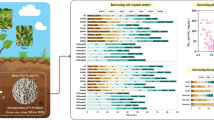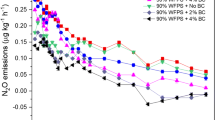Abstract
The benefits of biochar application are well described in tropical soils, however there is a dearth of information on its effects in agricultural temperate soils. An interesting and little explored interaction may occur in an intensive agriculture setting; biochar addition may modify the effect of commonplace N-fertilization. We conducted a field experiment to study the effects of biochar application at the rate of 0, 10 and 20 t ha-1 (B0, B10 and B20) in combination with 0, 40 and 80 kg N ha-1 of N-fertilizer (N0, N40, N80). We followed nitrous oxide (N2O) emissions, analysed a series of soil physicochemical properties and measured barley yield in a Haplic Luvisol in Central Europe. Seasonal cumulative N2O emissions from B10N0 and B20N0 treatments decreased by 27 and 25% respectively, when compared to B0N0. Cumulative N2O emissions from N40 and N80 combined with B10 and B20 were also lower by 21, 19 and 25, 32%, respectively compared to controls B0N40 and B0N80. Average pH was significantly increased by biochar addition. Increased soil pH and reduces NO-3 content seen in biochar treatments could be the two possible mechanisms responsible for reduced N2O emissions. There was a statistically significant increase of soil water content in B20N0 treatment compared to B0N0 control, possibly as a result of larger surface area and the presence of microspores having altered pore size distribution and water-holding capacity of the soil. Application of biochar at the rate of 10 t ha-1 had a positive effect on spring barley grain yield.
Similar content being viewed by others
References
Agegnehu G., Bass A. M., Nelson P. N & Bird M. I. 2016. Benefits of biochar, compost and biochar-compost for soil quality, maize yield and greenhouse gas emissions in a tropical agricultural soil. SciTot. Environ. 543: 295–306.
Agegnehu G., Bass A. M., Nelson P. N., Muirhead B., Wright G. & Bird M. I. 2015. Biochar and biochar-compost as soil amendments: Effects on peanut yield, soil properties and greenhouse gas emissions in tropical North Queensland, Australia. AgricEcosyst. Environ. 213: 72–85.
Anderson C. R., Hamonts K., Clough T. J. & Condron L. M. 2011. Biochar does not affect soil N-transformations or mi-crobial community structure under ruminant urine patches but does alter relative proportions of nitrogen cycling bacteria. AgricEcosyst. Environ. 191: 63–72.
Appel T. & Klein B. 2015. Mineralization and immobilization of nitrogen in soil amended with biochar, compost and co-composted biochar, pp. 112–113. In: Understanding biochar mechanisms for practical implementation, Hochshule Geisen-heim University.
Atkinson C. J., Fitzgerald J. D. & Hipps N. A. 2010. Potential mechanisms for achieving agricultural benefits from biochar application to temperate soils: a review. Plant Soil 337: 1–18.
Barrow C. J. 2012. Biochar: potential for countering land degradation and for improving agriculture. ApplGeogr. 34: 21–28.
Case S. D. C., McNamara N. P., Reay D. S. & Whitaker J. 2012. The effect of biochar addition on N2O and CO2 emissions from a sandy loam soil—the role of soil aeration. Soil Biol. Biochem. 51: 125–134.
Castaldi S., Riondino M., Baronti S., Esposito F. R., Marzaioli R., Rutigliano F. A., Vaccari F.P. & Miglietta F. 2011. Impact of biochar application to a Mediterranean wheat crop on soil microbial activity and greenhouse gas fluxes. Chemosphere. 85: 1464–1471.
Cayuela M. L., Van Zwieten L., Singh B. P., Jeffery S., Roig A. & Sánchez-Monedero M. A. 2014. Biochar’s role in mitigating soil nitrous oxide emissions: a review and meta-analysis. AgrEcosyst. Environ. 191: 5–16.
Clough T. J., Condron L. & Kammann Cand Müller C. 2013. A review of biochar and soil nitrogen dynamics. Agronomy 3: 275–93.
Czachor H. & Lichner Ľ. 2013. Temperature influences water sorptivity of soil aggregates. JHydrol. Hydromech. 61: 84–87.
Chintala R., Owen R., Kumar S., Schumacher T. E. & Malo D. 2014a. Biochar impacts on denitrification under different soil water contents. World Cong. Soil Sci. 6: 157–157.
Delgado J. A. & Follett R. F. 2010. Advances in nitrogen management for water quality. Soil Water Conservation Society, Ankeny, IA, 424 pp.
Fangueiro D., Senbayran M., Trindade H. & Chadwick D. 2008. Cattle slurry treat-ment by screw press separation and chemically enhanced settling: effect ongreenhouse gas emissions after land spreading and grass yield. BioresourTechnol. 99: 7132–7142.
Felber R., Leifeld J., Horák J. and Neftel A. 2013. Nitrous oxide emission reduction with greenwaste biochar: comparison of laboratory and field experiments. EurJ. Soil Sci. 65: 128–138.
Gruhn P., Goletti F. & Yudelman M. 2000. Integrated nutrient management, soil fertility, and sustainable agriculture: current issues and future challenges, 38 pp. In: Food, agriculture, and the environment discussion paper 32, IFPRI, Washington, USA.
HGCA. 2005. The barley growth guide. https://doi.org/www.hgca.com. (accessed 07.07.2016).
Hüppi R., Felber R., Neftel A., Six J. & Leifeld J. 2015. Effect of biochar and liming on soil nitrous oxide emissions from a temperate maize cropping system. Soil 1: 707–717.
Ippolito J.A., Novak J.M., Busscher W.J., Ahmedna M., Rehrah D. & Watts D.W. 2012. Switchgrass biochar affects two Aridisols. JEnviron. Qual. 41: 1123–1130.
Jones D.L., Rousk J., Edwards-Jones G., DeLuca T.H. & Murphy D.V. 2012. Biochar-mediated changes in soil quality and plant growth in a three year field trial. Soil Biol. Biochem. 45: 113–124.
Karer J., Wimmer B., Zehetner F., Kloss S. & Soja G. 2013. Biochar application to temperate soils: effects on nutrient uptake and crop yield under field conditions. AgrFood Sci. 22: 390–403.
Karhu K., Mattila T., Bergstroem I. & Regina K. 2011. Biochar addition to agricultural soil increased CH4 uptake and water holding capacity - Results from a short-term pilot field study. AgrEcosyst. Environ. 140: 309–313.
Laird D., Fleming P., Wang B., Horton R. & Karlen D. 2010. Biochar impact on nutrient leaching from a Midwestern agricultural soil. Geoderma 158: 436–442.
Lal R. 2009. Soils and food sufficiency. A review. AgronSust. Develop. 29: 113–133.
Leelamanie D.A.L. 2014. Initial water repellency affected organic matter depletion rates of manure amended soils in Sri Lanka. JHydrol. Hydromech. 62: 309–315.
Lehmann J., Gaunt J. & Rondon M. 2006. Bio-char sequestration in terrestrial ecosystems—a review. MitigAdapt. StratGlob. Change. 11: 395–419.
Lehmann J., Rillig M.C., Thies J., Masiell C.A., Hockaday W.C. & Crowley D. 2011. Biochar effects on soil biota, A review. Soil Biol. Biochem. 43: 1812–1836.
Liang B., Lehmann J., Solomon D., Kinyangi J., Grossman J., O’Neill B., Skjemstad J.O., Thies J., Luizăo F. J., Petersen J. & Neves E.G. 2006. Black carbon increases cation exchange capacity in soils. Soil Sci. SocAm. J. 70: 1719–1730.
Liyanage T.D.P. & Leelamanie D.A.L. 2016. Influence of organic manure amendments on water repellency, water entry value, and water retention of soil samples from a tropical Ultisol. JHydrol. Hydromech. 64: 160–166.
Liu E., Changrong Y., Xurong M., Wenqing H., So H. B., Lin-ping D., Qin L., Shuang L. & Tinglu F. 2010. Long term effect of chemical fertilizer, straw, and manure on soil chemical and biological properties in north-west China. Geoderma 150: 173–180.
Liu X.Y., Qu J. J., Li L.Q., Zhang A.F., Jufeng Z., Zheng J.W. & Pan G.X. 2012. Can biochar amendment be an ecological engineering technology to depress N2O emission in rice paddies? - A cross site field experiment from South China. EcolEng. 42: 168–173.
Nelissen V., Ruysschaert G., Manka’Abusi D., D’Hose T., De Beuf K., Al-Barri B., Cornelis W. & Boeckx P. 2015. Impact of a woody biochar on properties of a sandy loam soil and spring barley during a two-year field experiment. EuropJ. Agronomy 62: 65–78.
Schnell R.W., Vietor D.M., Provin T.L., Munster C.L. & Ca-pareda S. 2012. Capacity of biochar application to maintain energy crop productivity: soil chem-istry, sorghum growth, and runoff water quality effects. JEnviron. Qual. 41: 1044–1051.
Shen J., Tang H., Liu J., Wang C., Li Y., Ge T., Jones D. L. & Wu J. 2014. Contrasting effects of straw and straw-derived biochar amendments on greenhouse gas emissions within double rice cropping systems. AgrEcosyst. Environ. 188: 264–274.
Simek M. & Cooper J.E. 2002. The influence of soil pH on deni-trification: progress towards the understanding of this interaction over the last 50 years. EuroJ. Soil Sci. 53: 345–354.
Singh B. P., Hatton B.J., Singh B., Cowie A.L. & Kathuria A. 2010. Influence of biochars on nitrous oxide emission and nitrogen leaching from two contrasting soils. JEnviron. Qual. 39: 1224–1235.
Steiner C., Teixeira W.G., Lehmann J. & Zech W. 2007. Long term effects of manure, charcoaland mineral fertilization on crop production and fertility on a highly weathered central amazonian upland soil. Plant Soil. 291: 275–290.
Suddick E.C. & Six J. 2013. An estimation of annual nitrous oxide emissions and soil quality following the amendment of high temperature walnut shell biochar and compost to a small scale vegetable crop rotation. SciTotal Environ. 65: 298–307.
Sutton M.A. & van Grinsven H. 2011. The European nitrogen assessment. Sources, effects, and policy perspectives. Cambridge Univ. Press, Cambridge, UK, 664 pp.
Van Zwieten L., Kimber S., Morris S., Downie A., Berger E., Rust J. & Scheer C. 2010. Influence of biochars on flux of N2O and CO2from Ferrosol. AustJ. Soil Res. 48: 555–568.
Verhoeven E. & Six J. 2014. Biochar does not mitigate field-scale N2O emissions in a Northern California vineyard: an assessment across two years. AgricEcosyst. Environ. 191: 27–38.
Yan F., Schubert S. & Mengel K. 1996. Soil pH increase due to biological decarboxylation of organic anions. Soil Biol. Biochem. 28: 617–624.
Yuan J., Xu R., Qian W. & Wang R. 2011a. Comparison of the ameliorating effects on an acidic ultisol between four crop straws and their biochars. JSoil Sediment 11: 741–750.
Yuan J., Xu R. & Zhang, H. 2011b. The forms of alkalis in the biochar produced from crop residues at different temperatures. BioresTechnol. 102: 3488–3497.
Zhang A., Cui L., Pan G., Li L., Hussain Q., Zhang X., Zheng J. & Crowley D. 2010. Effect of biochar amendment on yield and methane and nitrous oxide emissions from a rice paddy from Tai Lake plain, China. AgrEcosyst. Environ. 139: 469–475.
Zhang A., Bian R., Pan G., Cui L., Hussain Q., Li L., Zheng J., Zheng J., Zhang X., Han X. & Yu X. 2012. Effects of biochar amendments on soil quality, crop yield and greenhouse gas emission in a Chinese rice paddy: a field study of 2 consecutive rice growing cycles. Field Crop Res. 127: 153–160.
Author information
Authors and Affiliations
Corresponding author
Rights and permissions
About this article
Cite this article
Horák, J., Kondrlová, E., Igaz, D. et al. Biochar and biochar with N-fertilizer affect soil N2O emission in Haplic Luvisol. Biologia 72, 995–1001 (2017). https://doi.org/10.1515/biolog-2017-0109
Received:
Accepted:
Published:
Issue Date:
DOI: https://doi.org/10.1515/biolog-2017-0109




